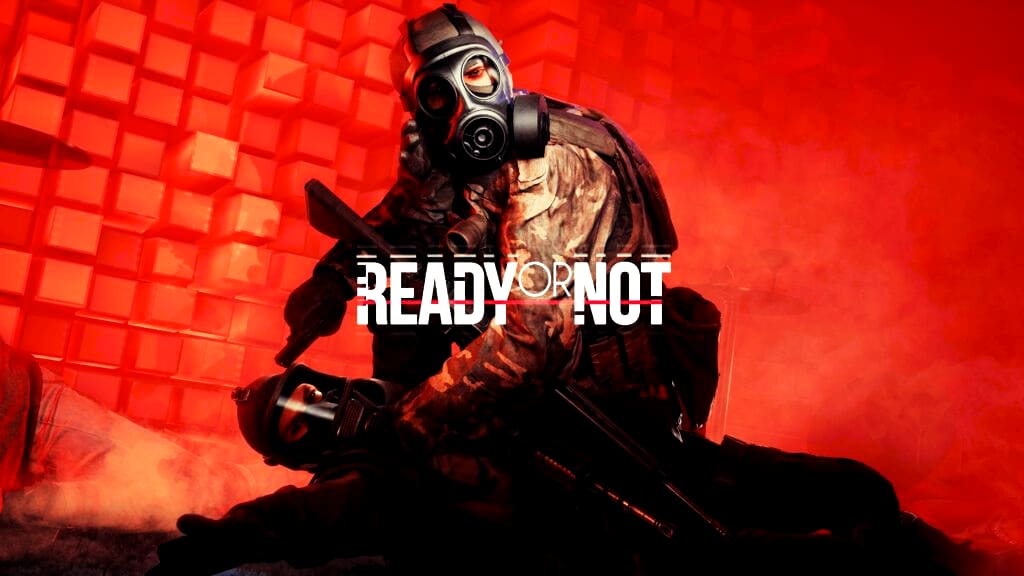Two years after the start of Early Access, the spiritual successor to SWAT 4 is finally ready. We feared the worst, but are thrilled
The announcement of the final release of Ready or Not is like a well-planned police operation. The tactical hopeful was quiet for a long time in Early Access. At the Game Awards 2024, the developers from VOID Interactive struck cold in a concentrated campaign and announced the launch of version 1.0 for mid-December. So it”s time for a new test!
As a police SWAT unit, we battled petty crooks and serious criminals alone and in 4-player co-op. Not only did we have a lot of fun, but we were also impressed by the significant step forward in Ready or Not since our last review We”ll now find out how it all plays and whether the shooter can maintain its quality over the entire playing time in our review.
Table of Contents
We are SWAT!
Ready or Not aims to fill a gap that has been gaping since the mid-2000s: After titles such as Tom Clancy”s Rainbow Six 3: Raven Shield (2003) and SWAT 4 (2005), there were no more notable entries in the niche genre of tactical shooters with a police setting. To make a long story short: Ready or Not easily fills this vacancy and finally provides new fodder for tacticians who have been starving for so long.
In the fictitious US metropolis of Los Sueños, we are part of the SWAT team, the special police unit. We move in when situations get out of control: Hostage-takings, bomb threats, raids and the like, we and our elite police officers are both the spearhead of the law and the last hope for all innocent parties involved.
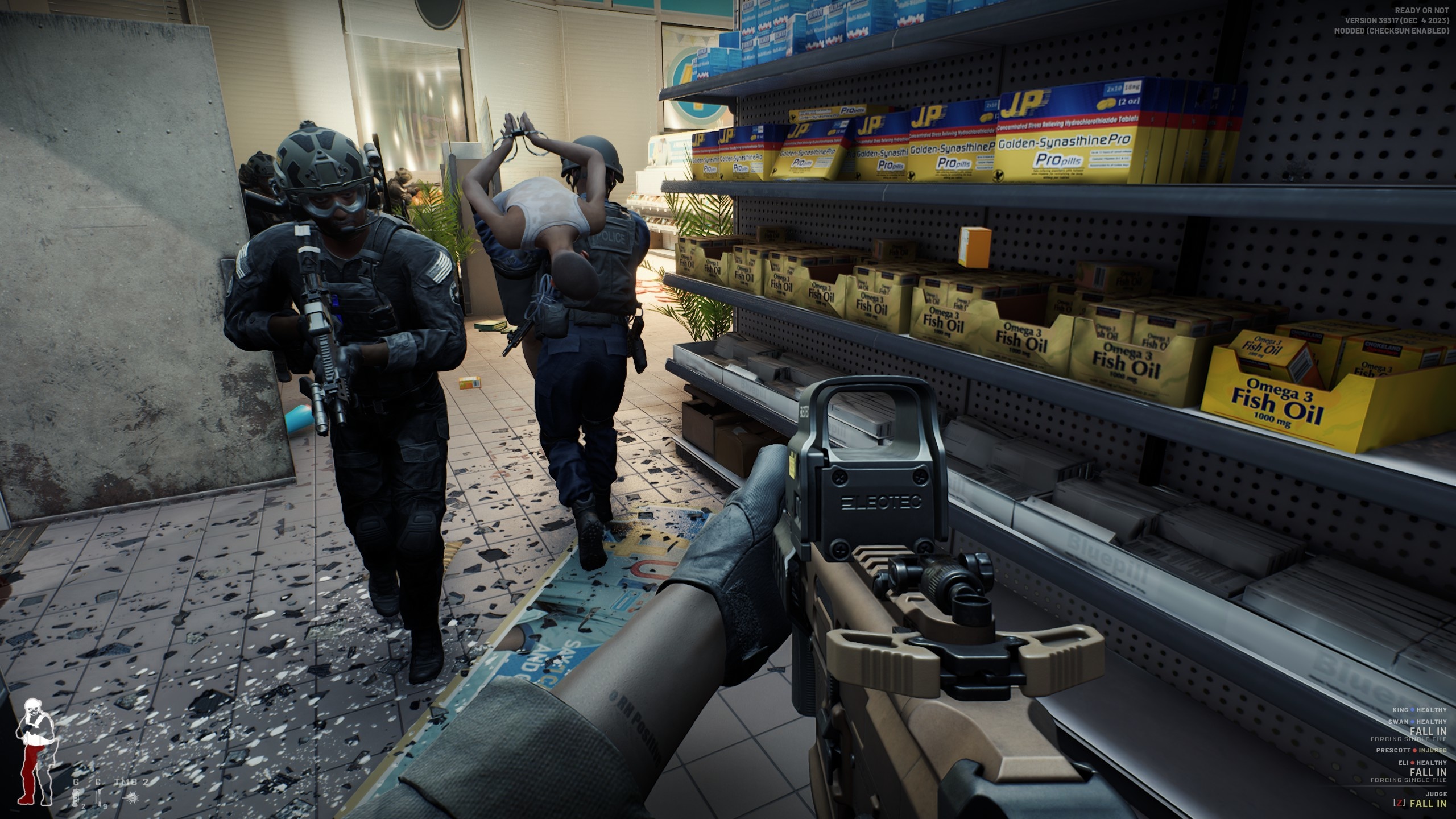
We interpret our role as police officers less like John McClane from Die Hard (“Yippie-ya-yay, pig cheeks!”), but more like FBI investigators: in accordance with the rules and with the aim of persuading enemies to give up instead of just shooting. Our actions are defined by the so-called “Rules of Engagement”. They specify when lethal force is justified.
Simplified: We may only shoot at enemies who attack us. As long as they don”t, we have to ask even the fiercest opponents to surrender – and possibly help them out with stun grenades and the like. If we behave like an axe in the forest, we get minus points and a bad rating at the end of the mission. We”ll explain exactly how this works and how the system fits into the game later on.
Focus on story and atmosphere
Ready or Not aims to impress in two disciplines in particular: an atmospherically dense story experience reminiscent of the best moments of SWAT 4 and varied gameplay with lots of weapons, gadgets and a deeply rooted tactical DNA.
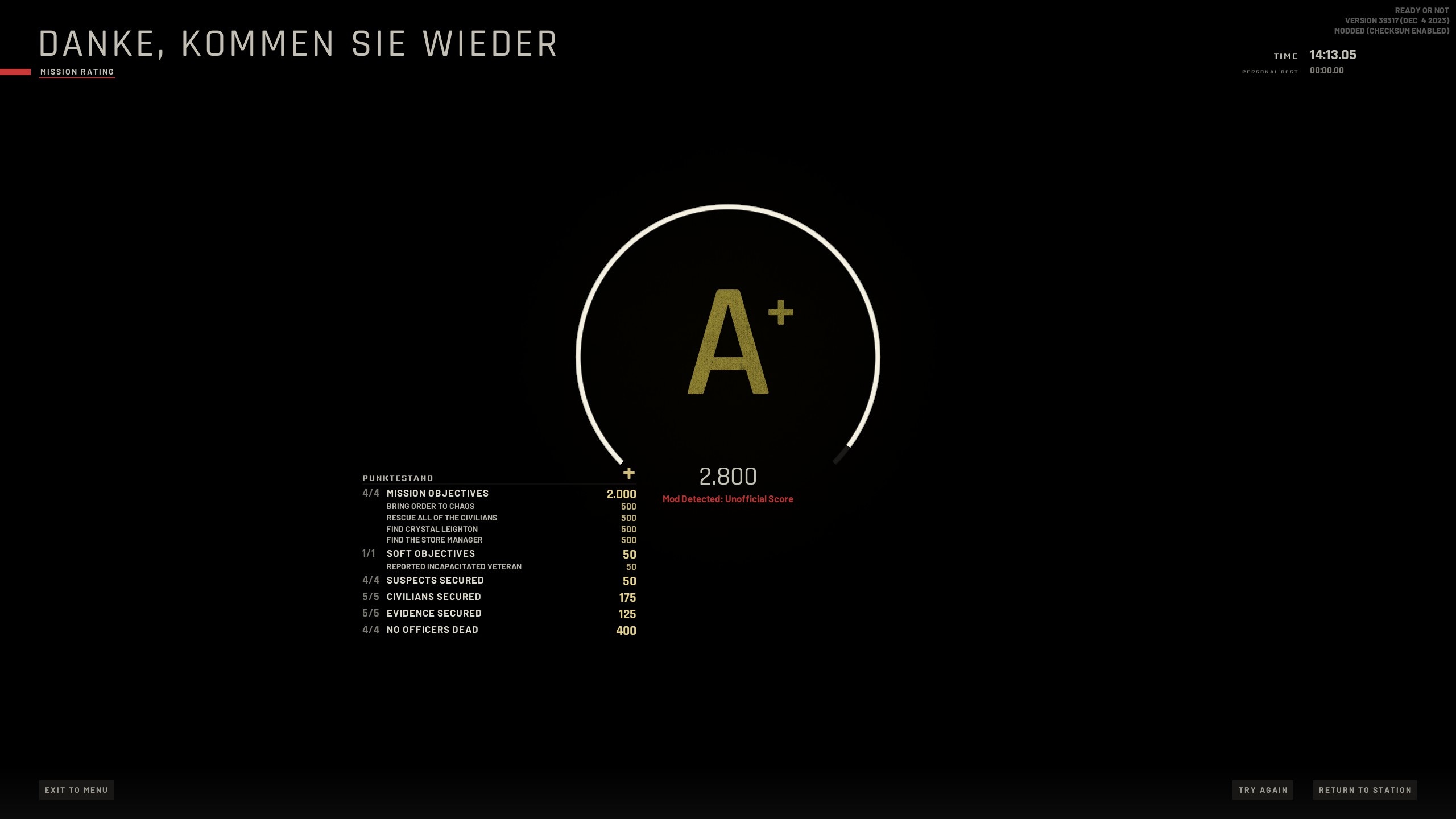
While we criticized the loveless level design and the contextless mission presentation during Early Access, we can hardly believe our eyes here. In the release version of Ready or Not, there 18 missions, all of which impress with their detailed locations. Crime scenes finally look the part: In the salesroom of a petrol station occupied by trigger-happy criminals, the floor is lined with shelves. But we mustn”t allow ourselves to be distracted, because a trigger-happy gangster could be lurking around every corner.
When we secure the apartment of a streamer running amok in another mission in an apartment block, we not only burst into the live broadcast (keyword: “swatting”), but also admire figures, posters and other nerdy stuff almost enviously.
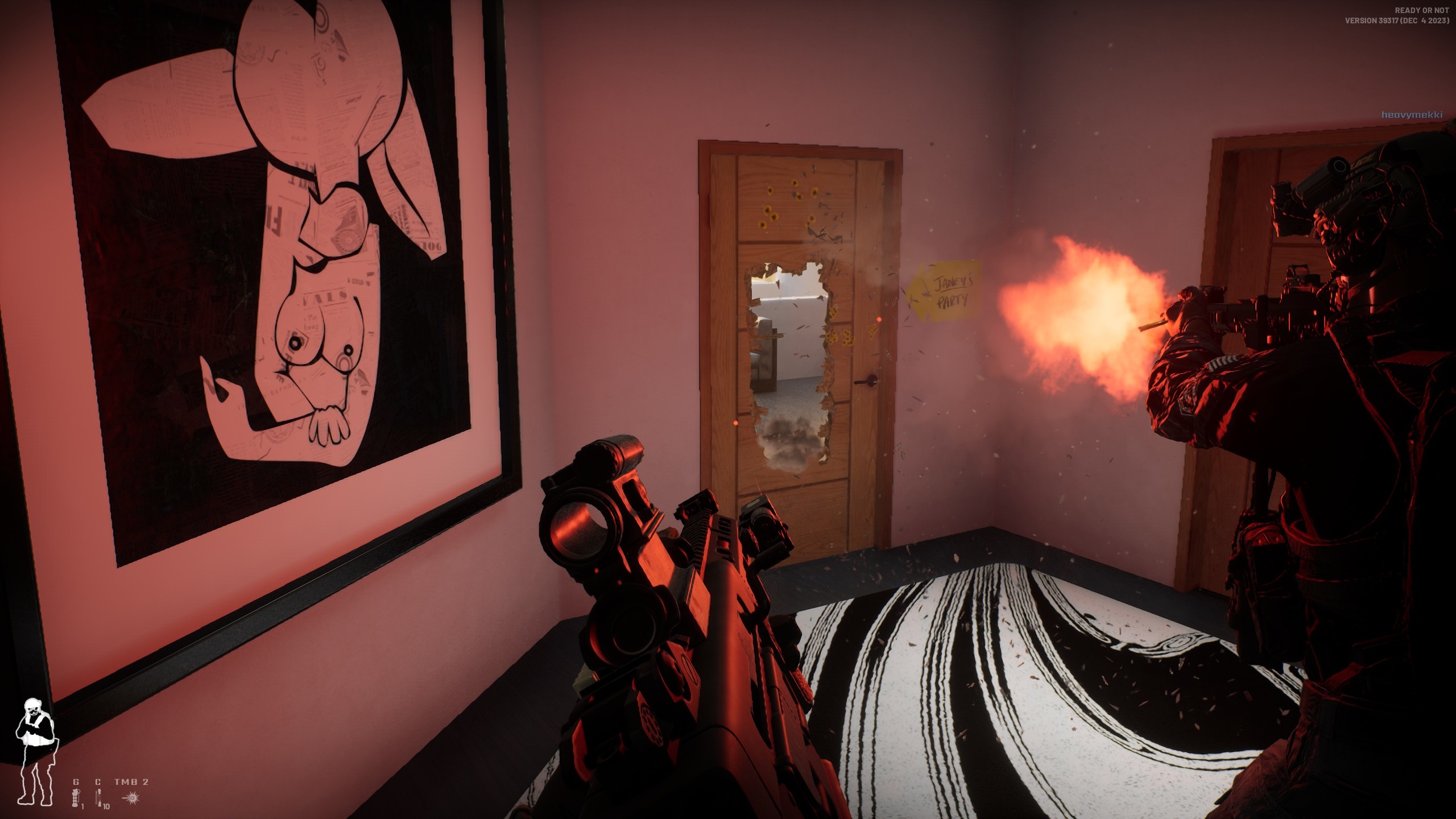
We find allusions to pop culture again and again: In the remote forest hut of a prepper, traps and enemies that move quickly and unpredictably through air shafts and false floors await us. On a flipchart is a drawing of a SWAT policeman with the note: “Aim for their limbs.” Oh yes, and there”s a burning mobile home outside
The game needs these moments to lighten the mood, because the storyline, which is told indirectly via evidence found and secured crime scenes, is not for the faint-hearted. Time and again we find clues about organized child abuse and uncover further background information as the campaign progresses. In terms of tension and intensity, some of the missions easily match the house of the serial killer from SWAT 4. Unfortunately, Ready or Not misses the chance to tell a truly coherent and well-presented story. The potential is definitely there.
A briefing at last!
The atmosphere in the varied levels is great. Finally, the surroundings too! As we are used to from SWAT, we finally get a meaningful mission briefing in Ready or Not. By pressing TAB, we can open our mission tablet and find all the information on the situation, background, suspects, suspected weapons, hostages and more. We can even listen to the emergency calls received by the police station. Because we often have to capture certain targets alive, we study the footage carefully. In addition, there is finally a map on which we can even place our own markers and paths. This finally gives us a real sense of action
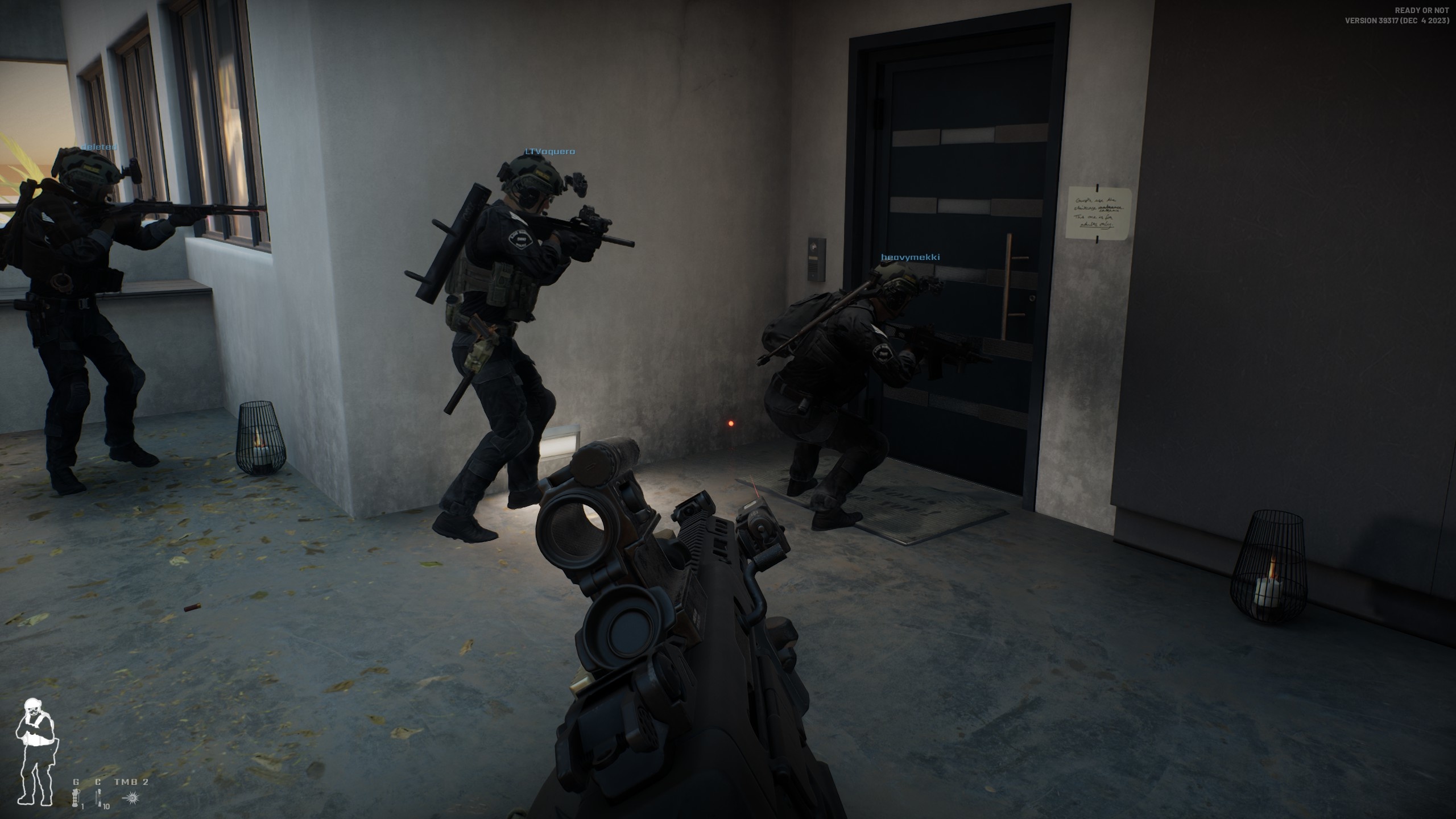
Unfortunately, this operational feeling has not yet fully arrived at the scenes themselves. When we arrive at the crime scene, we should actually find a situation that resembles a spectacle: cordoned-off streets and access roads, police cars, sirens, media and onlookers – all this is missing. At best, there are two official cars next to our SWAT truck, but that”s about it.
This is particularly unfortunate when – as in the mission with the petrol station – we find material from a news broadcast in the briefing. Where are the reporters who shot the footage on location? And where are the police officers who called in SWAT in a hopeless situation and secured the crime scene until then? There is still room for improvement here, but Ready or Not has taken a huge step towards more credibility and better storytelling overall with the new briefing
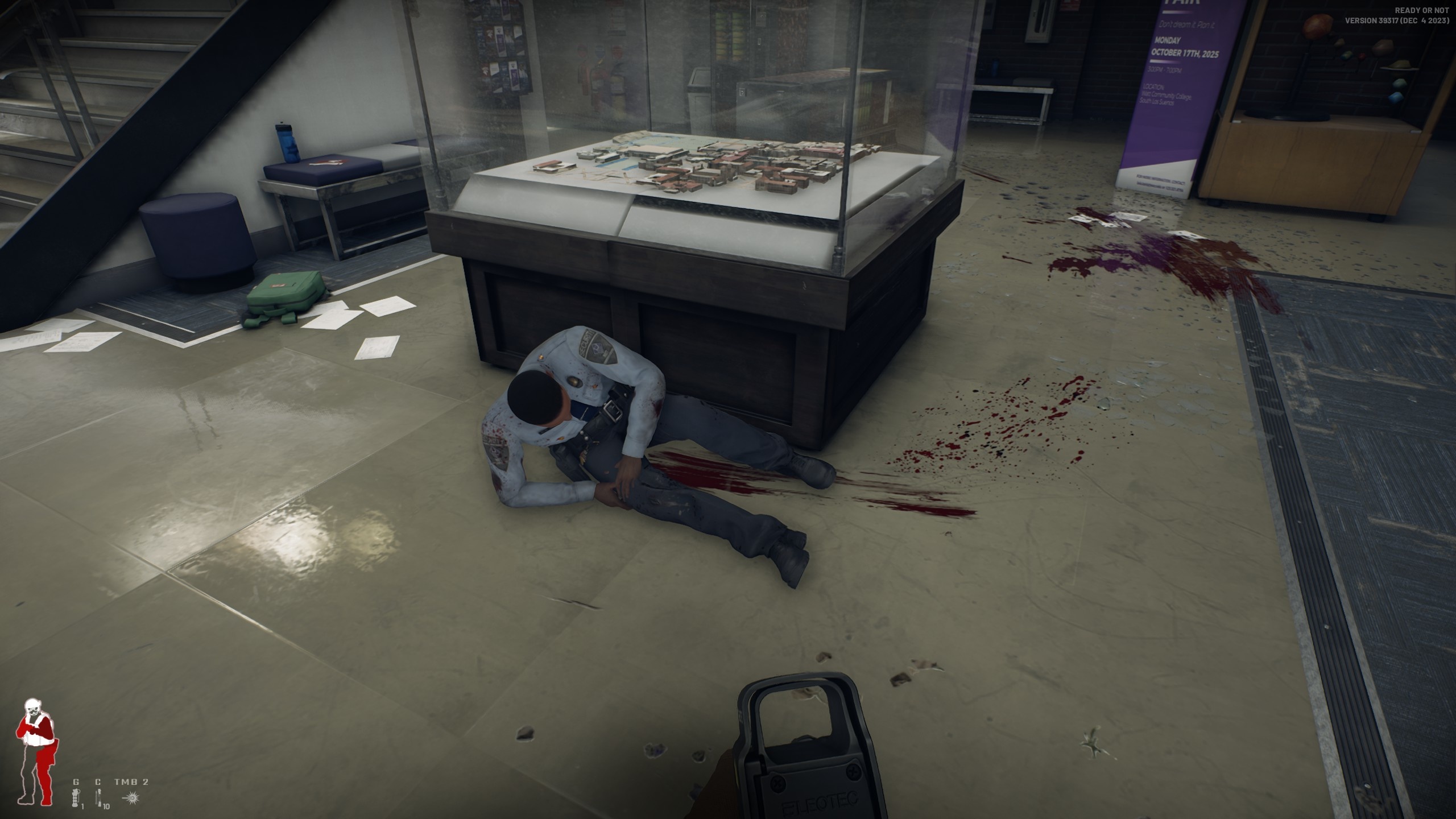
SWAT headquarters as a lobby
Storytelling is also a perfect keyword for the focus on immersion. Ready or Not is a far cry from the Early Access mission playlist, instead putting us in the role of an elite police officer in a believable way. So far, this has been done via the detailed replica of the main police building in Los Sueños. In the final version of Ready or Not, this is of course also the case again, but the police station has been completely redesigned. In both single and multiplayer, the premises serve as a HUB area and lobby
In the briefing room we choose the next mission, in the changing room we decide on equipment and appearance and in the basement we put the many first-class modeled weapons through their paces at the shooting range. The LSPD is populated by AI police officers. We can”t interact with them, but their presence adds to the credibility
In single player like SWAT 4
In addition to a tutorial, Ready or Not has a single and a multiplayer mode. The heart of the single player is Commander Mode, in which we take on the role of David “Judge” Beaumont. Together with four AI colleagues (Team Blue and Team Red), we work our way through the city”s varied locations. In addition to the aforementioned petrol station and the residential complex, we ensure law and order in the penthouse, harbor, luxury villa, college and hotel, for example.
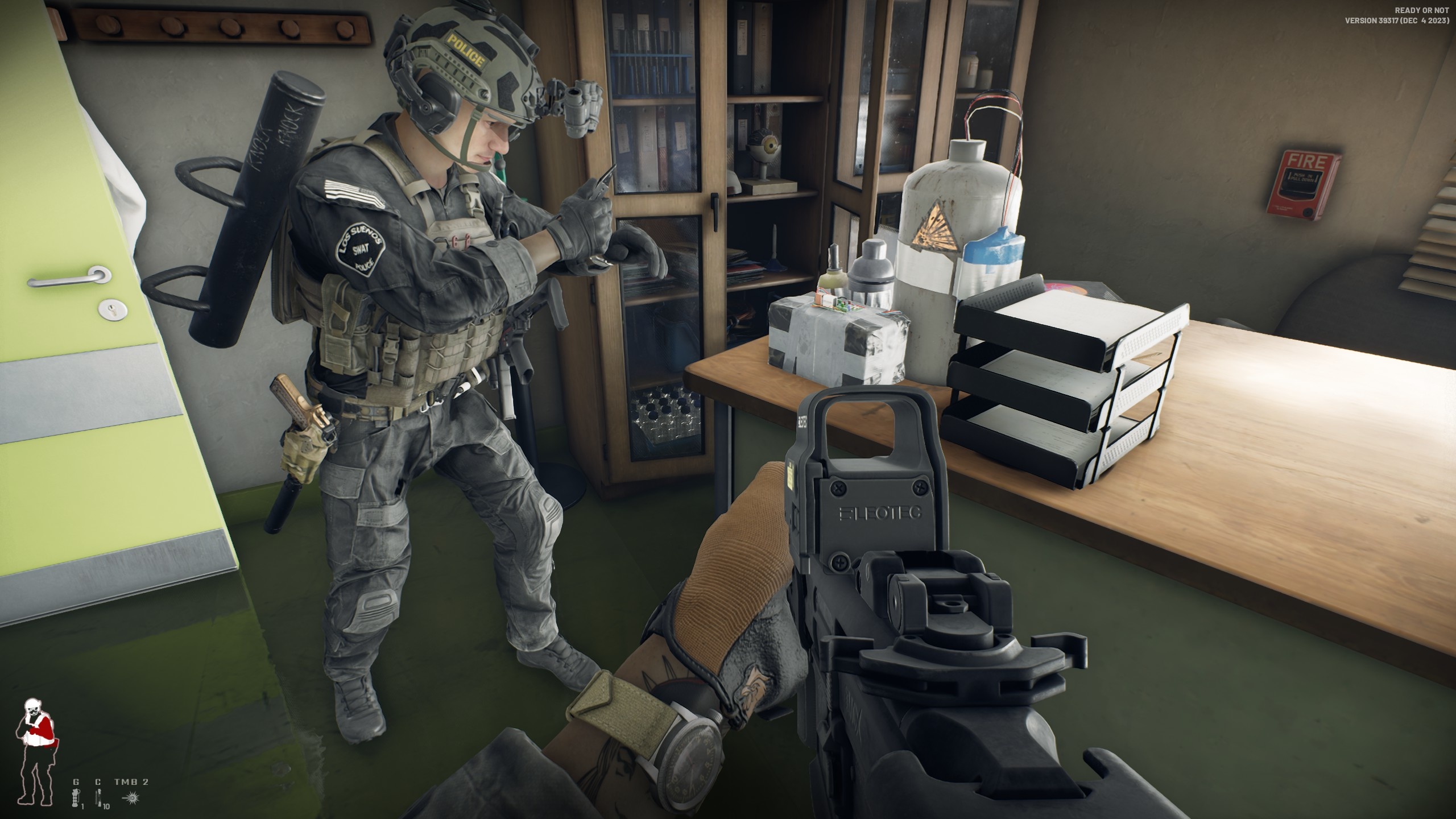
At headquarters, we assemble our team and determine the equipment of each individual. This mechanic is surprisingly complex: we select four colleagues from a pool of police officers for the next mission. With successfully completed missions, they gain experience and unlock their respective special skills. For example, James Martinez is a specialist in smashing through doors. When he is in the game, explosive devices contribute more to unsettling enemy or civilian characters, which may lead to a quicker task.
Keeping the team together and developing it brings tangible benefits. It”s all the worse when we lose a beloved officer – and with them their special expertise. After each mission, we check the stress level of our colleagues in the team menu. If someone is stressed or even in a crisis, we should give them a break. If nothing else works, the company doctor gets in touch and prescribes therapy. Rotating team members is therefore a must. The hardcore mode called “Ironman” makes the whole thing even more difficult. We only have one life in this too.
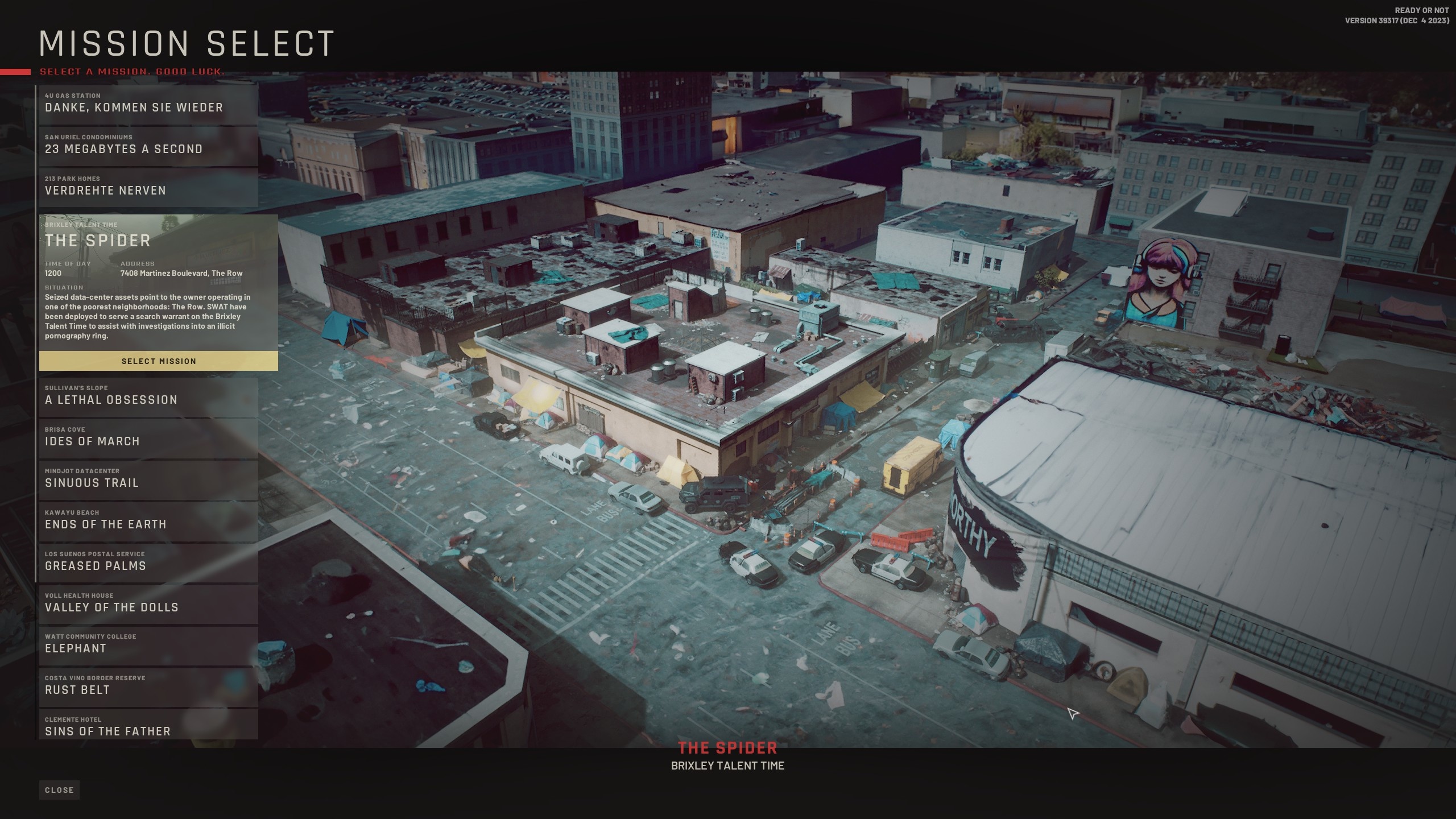
This is where the game mechanics and the above-mentioned rating system work well together. If we behave correctly and achieve all the mission objectives, the mission goes more or less according to plan and we get a high score. If we violate the rules, work inaccurately and suffer losses as a result, this not only affects the score, but also the morale of the police officers. They then need to take breaks earlier or are no longer focused on the mission.
If an officer goes into a mission with the mental status “crisis”, he is not as efficient as a balanced colleague. Although the team management in Ready or Not is minimalist, it serves its purpose very well
Our line of sight is essential for the commands. If we look at a locked door, we have appropriate actions such as setting up, checking, breaking open and securing to choose from. However, when we are looking around a corner and holding down the keys for it, the command menu is too fiddly.
We can also string together commands while holding down the SHIFT key and have them executed in parallel by pressing a button. In this way, precise access to several points is possible, ideally without bloodshed. In most cases, parallel access also works, but there are still situations in which the otherwise really good AI drops out.
If Team Red is supposed to break down a door and then Blue takes over during the execution, Red comes to me and we don”t complete the mission because of this mess, that”s annoying. In addition, for lineups in narrow aisles, the partner AI could be a bit more permeable so that they don”t block us as much.
But again, such situations do exist, but they are exceptions. Basically, friend and foe AI act very well and realistically. Enemies don”t necessarily wait until we”ve finally lined up at a door to overpower us. Often they just rush out and take us by surprise. They also like to flank and ambush.
If an enemy has surrendered, the all-clear is by no means given: the criminals often draw hidden knives or pistols during the arrest. We always keep a close eye on cabinets and the fact that booby traps on doors are dynamically redistributed with each pass makes us feel pleasantly paranoia.
(If we encounter a hostage, we secure it and report it. If gangsters surrender, caution is still advised: they can draw hidden weapons and sneakily kill us).
Large repertoire of weapons …
As commander, we not only select the police officers at our side, but also decide on their equipment. In addition to main and secondary weapons, this also includes grenades, armor and tactical toys. When it comes to weapons, we choose from the usual suspects in the categories assault rifles, submachine guns, shotguns and pistols Some of these are also available in non-lethal versions
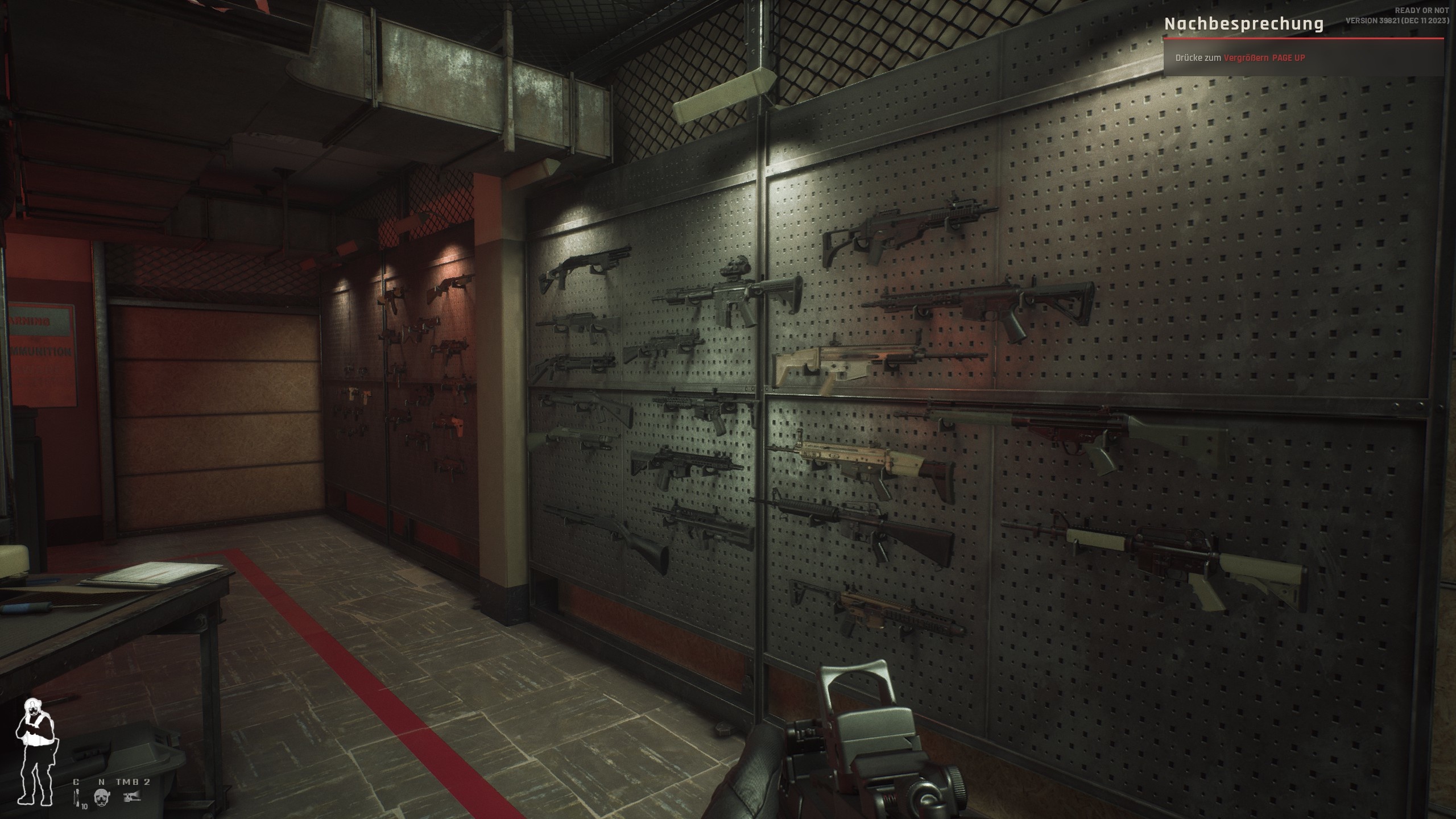
The choice of armor determines the wearer”s protection on the one hand. It also influences the speed of movement and magazine carrying capacity. There is also a choice of ammunition: armor-piercing bullets penetrate light cover and penetrate medium protective equipment. Hollow-point bullets expand on impact, but do less damage behind cover and protective equipment.
That”s why a meaningful briefing is so important: Are we going to have to deal with a few half-strength foamers? Then light protective clothing with a stab vest against knives might be enough. Are there reports of entrenched war veterans? Then we”d better move in with heavy body armor and armor-piercing ammunition
It gets tricky when we have to defuse a bomb under time pressure. Do we rely on maximum movement speed and tend to make ourselves more vulnerable? Or do we need the extra protection when we have to move faster through the level? We love Ready or Not because of moments like this
.. and tactics
In the field, we command our team via an easy-to-use menu. Using the mouse wheel, we choose whether we address all teams (Team Gold) or just one team at a time (Blue/Red). We use the space bar to enter the command, which is displayed as logical in the bottom right corner. The middle mouse button opens the correct command menu, in which we can tell who does what and when with just a few clicks. This takes a little time to get used to, but is then easy to use.
Our line of sight is essential for the commands. If we are looking at a locked door, we have a choice of actions such as open, check, break open and secure. However, if we are looking around a corner and hold down the buttons, the command menu is too fiddly
We can also string commands together by holding down the SHIFT key and execute them in parallel by pressing a key. Ideally, this allows precise access to several locations without spilling blood. In most cases, parallel access also works, but there are still situations in which the otherwise very good AI fails.
It”s annoying when Team Red is supposed to break down a door and then Blue takes over during the execution, Red comes to me and we don”t complete the mission because of this confusion. The partner AI could also be a bit more permeable in narrow corridors so that they don”t block us so much.
But again, these situations are there, but they are exceptions. Basically, friend and foe AIs act very well and realistically. Enemies don”t necessarily wait until we”ve finally lined up at a door to overpower us. They often just rush out and take us by surprise. They also like to flank and strike from ambushes.
Once an enemy has surrendered, don”t give the all-clear: criminals often pull out hidden knives or pistols when they are arrested. We always keep a close eye on cupboards and the fact that booby traps on doors are dynamically redistributed every time we go through them makes us feel paranoid
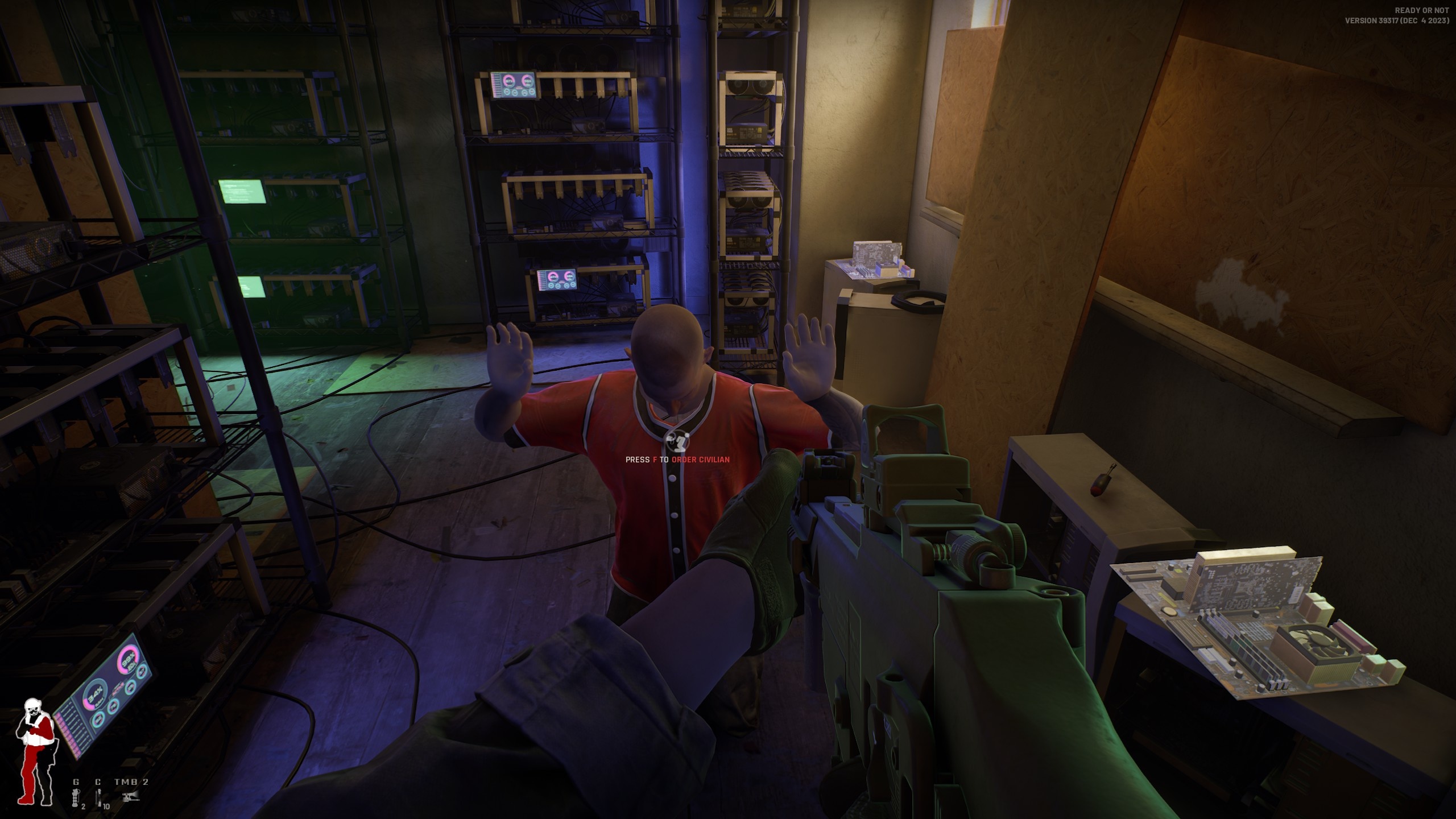
We counter the chaos on the other side with structure and a methodical approach. Ready or Not places a strong focus on realism. Real tactics from real SWAT teams are available in the game. With “Slice”, we give an officer the order to slowly work his way around a corner, like a knife slicing its way around a cake. We ourselves hold down the ALT key and peer far around corners in order to provide less of a target. If we walk slowly while holding down the SHIFT key, we make less noise.
We still can”t race, but we can lower the weapon at the touch of a button, as in Hunt: Showdown to move a little faster. The same applies to doors: we open them slowly or kick them in. Or we open them a crack. Or we use the mirror to check for booby traps beforehand. Both tactics and movement modes are tools that we should use urgently. Those who see Ready or Not only as a shooter will have little fun despite great weapon handling and sometimes die many deaths. The good thing is that even sudden failure is usually understandable
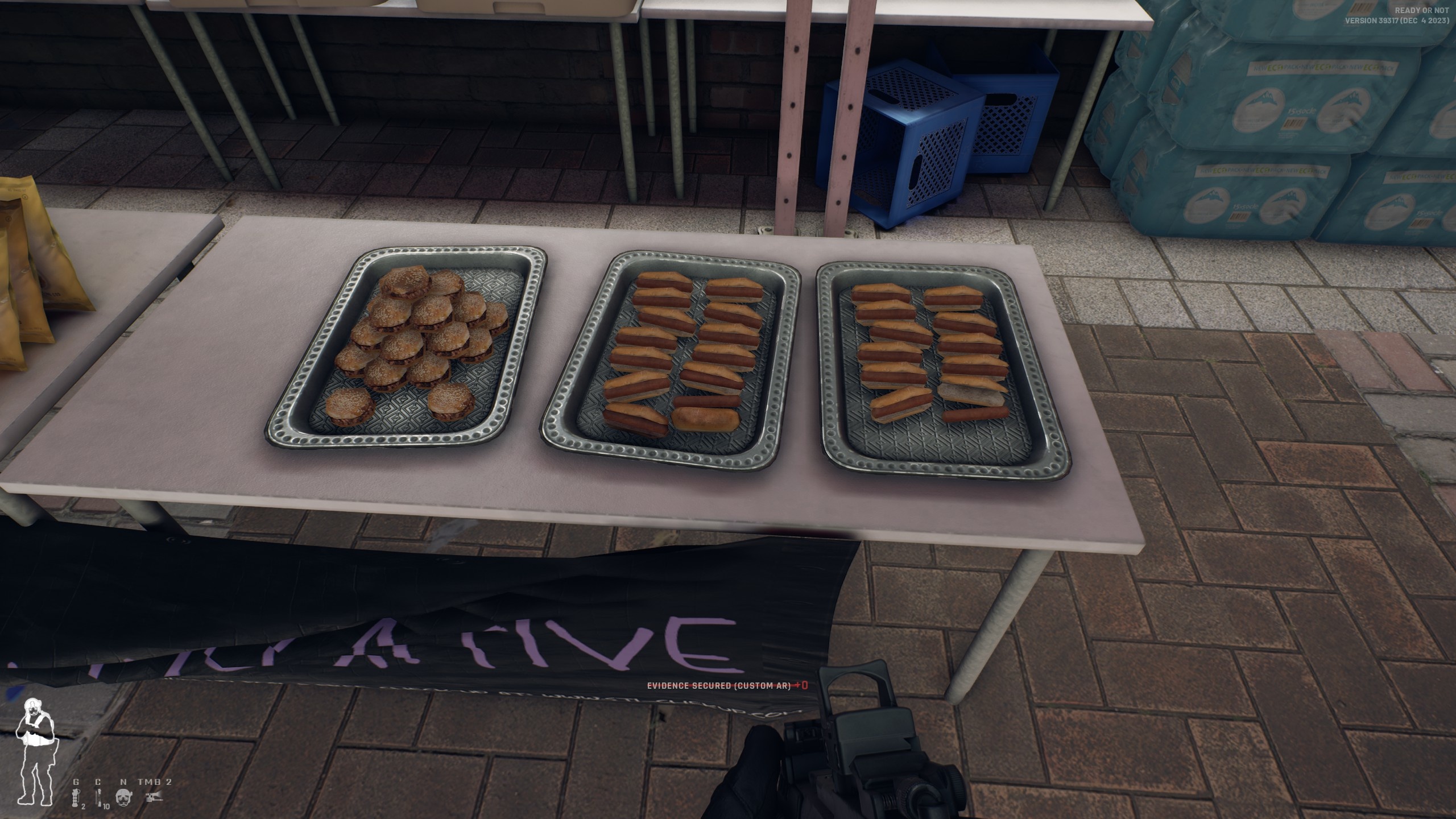
Differently fascinating in multiplayer
In co-op mode there are also five of us The aspects with the commander and the team management are omitted, but the coordination among each other is very important. To this end, there is text chat and VoIP at the touch of a button. We spoke via Discord during our rounds. We enter the game by either joining a lobby or starting our own game. In the settings, we specify whether everyone can join or only our friends
The more experienced the teams are, the more dynamically Ready or Not plays in co-op. Procedures are quicker if you coordinate with each other instead of forging chains of command in the menu for every action. However, this dynamic tempts you to be careless. Ready or Not is also challenging in multiplayer mode and is not a shooting gallery. Although it has a different focus than the single-player version, the multiplayer part is fascinating in its own way and definitely worth a recommendation.
(If we are out of action in co-op mode, we continue to watch our colleagues via the helmet camera.)
What does the technology say?
Ready or Not uses the Unreal Engine 4 and looks very good. The individual locations impress with lots of visual details, the graphics are coherent and create a great atmosphere. Occasionally there are still problems with dynamic shadows when only a few parts of our weapon are visible. There are occasional errors with tessellation when balls become angular even at close range.
The ragdoll effects often make situations unintentionally funny when we put shackles on dead or wounded people. They may then slide around wildly in the area until they find their position in the level. If we activate raytracing options in the settings, they are still displayed as switched off. In the corresponding ini file, however, raytracing is then noted as activated:
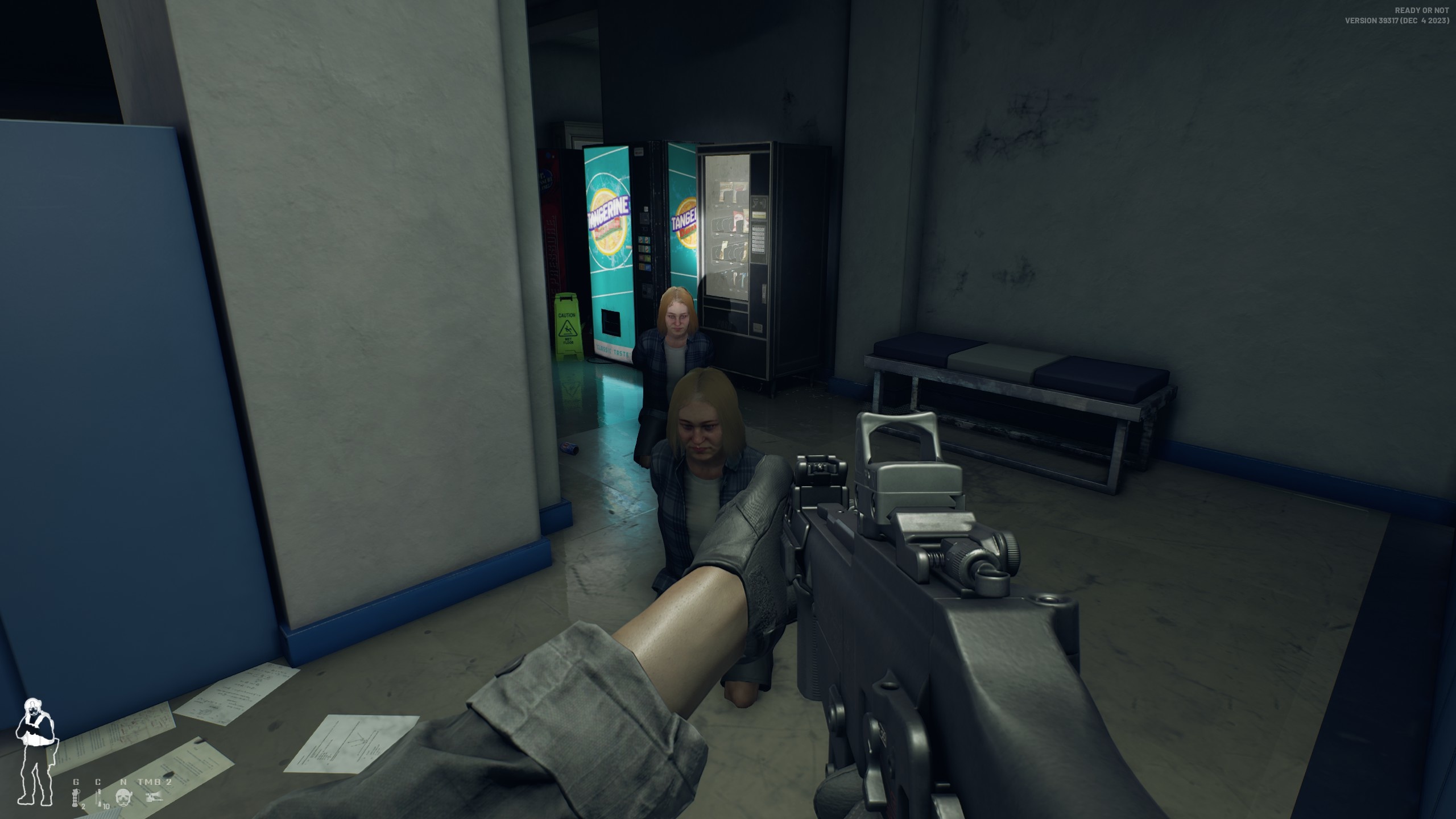
These are all quite noticeable little things, but none of them occur too often or negatively affect the game. Ready or Not runs stable and smoothly overall. The mission on Cherryessa Farm was a negative example until shortly before release, because we had severe frame rate drops here. With the latest patch, however, this mission is also playable without any problems
Since the start of Early Access, it has been clear that the developers at VOID Interactive have been working hard and with great dedication on their game. We are sure that this will continue to apply to both content and technology in the future. In any case, this game has hardly anything in common with the version released two years ago. The closest thing to this is the state of localization of the written texts: if we set the game to German, a wild mix of German and English awaits us. At least that didn”t bother us. But if you don”t want that, switch to English and you won”t have the problem.
Compared to the problems two years ago, however, these are trifles. We were very disappointed back then when we were finally able to play ourselves after the great trailers and the many ideas. It”s all the better to see the next step in this development.
Conclusion of the editorial team
I”m so glad that Ready or Not has become this game for release. I can finally immerse myself in the great scenarios and choose tactics and equipment based on the information in the briefing. The single-player mode reminds me a lot of SWAT 3, where I also worked my way through the campaign with my team. In Ready or Not, I want to take care of my colleagues, keep them alive and use their special abilities
The changing dynamics in multiplayer are great. Tactics with friends are fun and when we get gangsters to give up and then achieve the highest score, it feels really great. The focus on realistic processes and the different tactics and active AI – both with the enemies and with our colleagues – make a big contribution.
If I had a few wishes, I would be in favor of filling the headquarters with even more life, reissuing a few missions from SWAT & Rainbow Six and further expanding the team management system. But who knows: Ready or Not has already surprised me a few times. Maybe it will do it again

